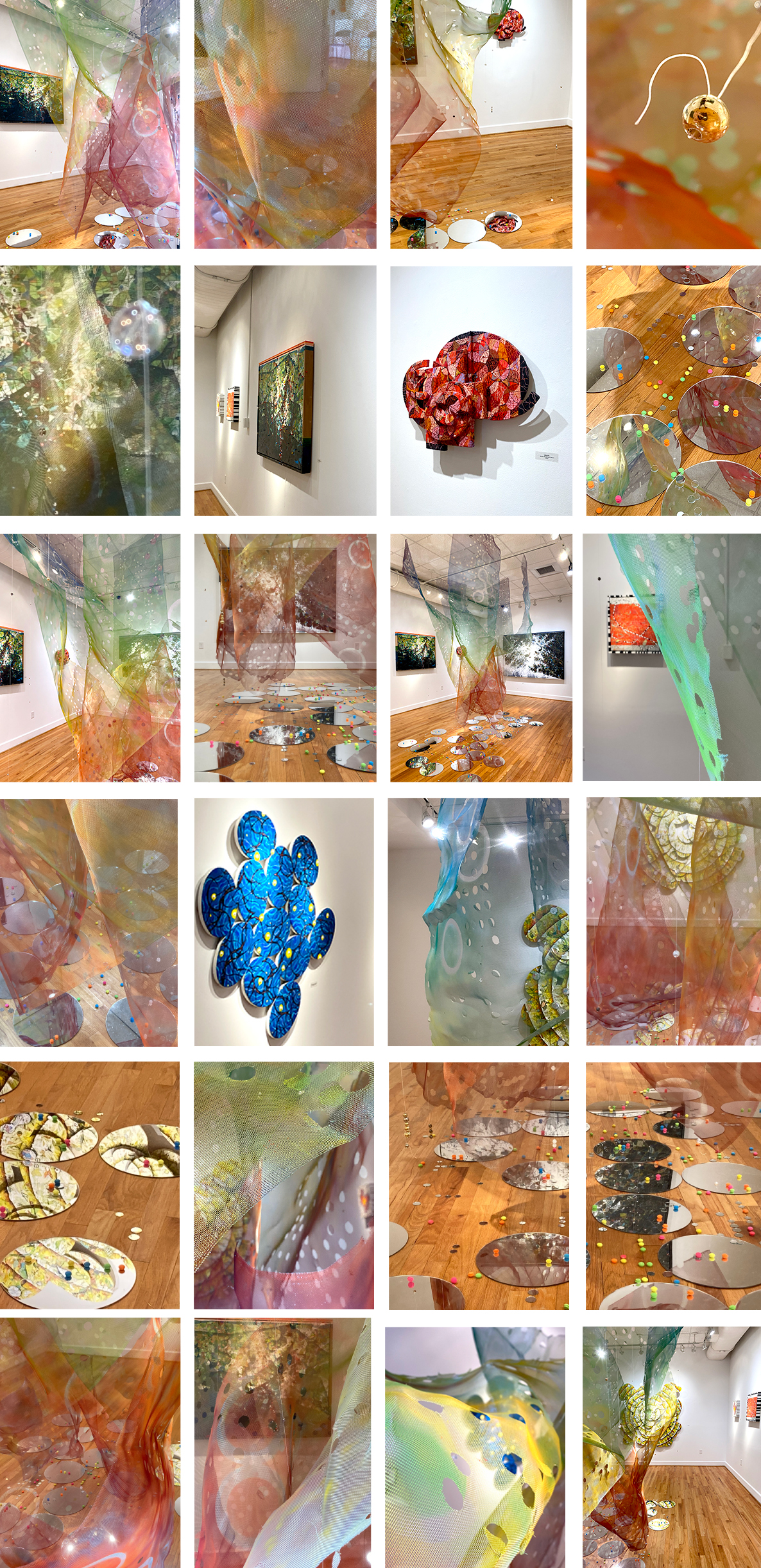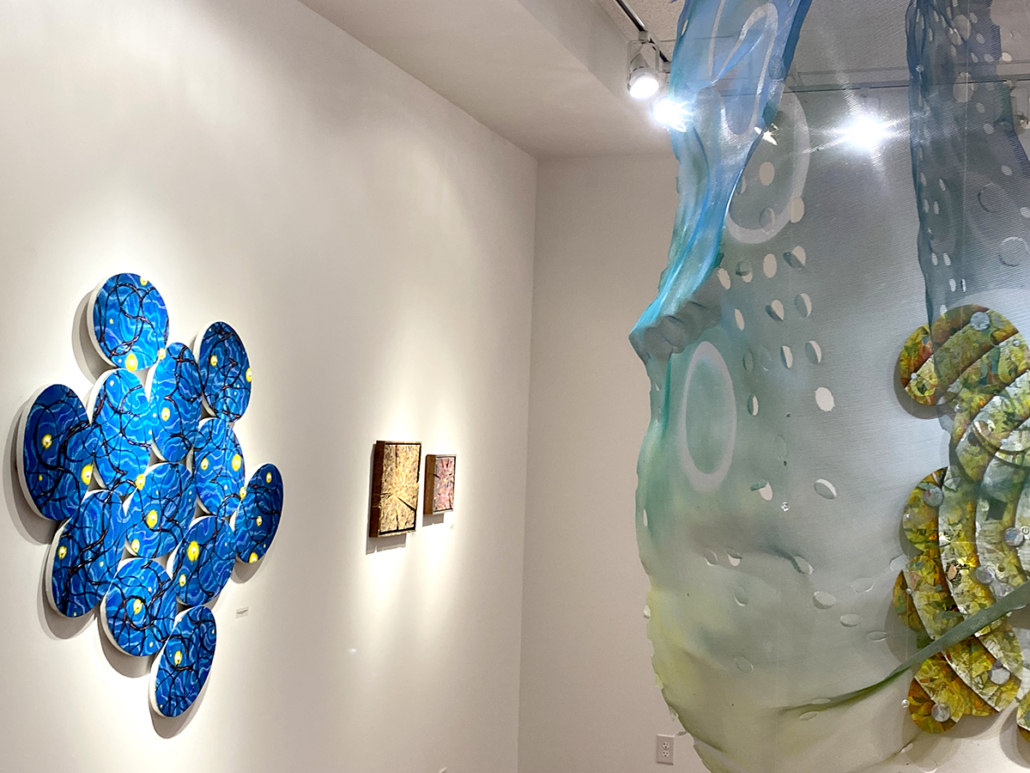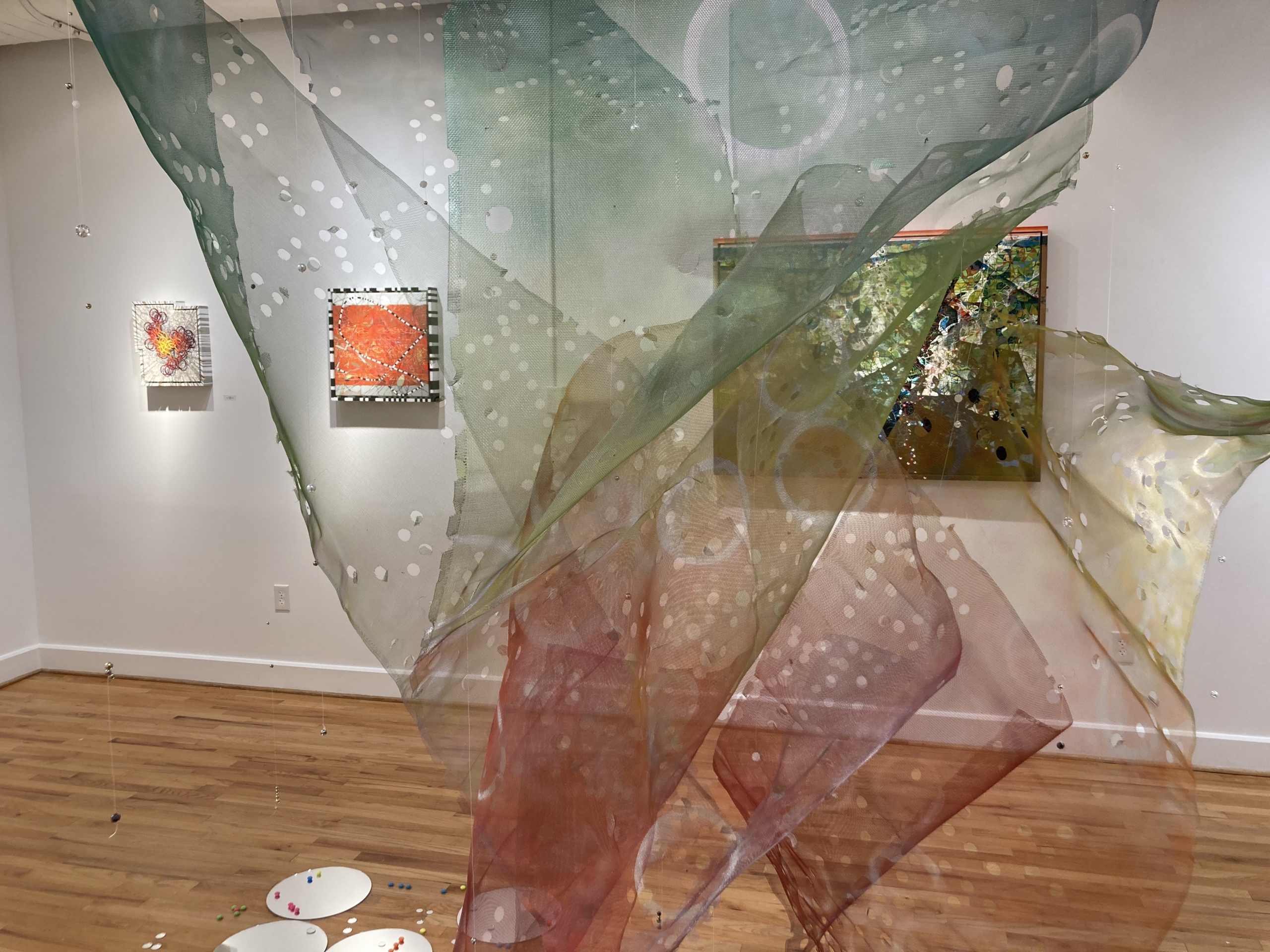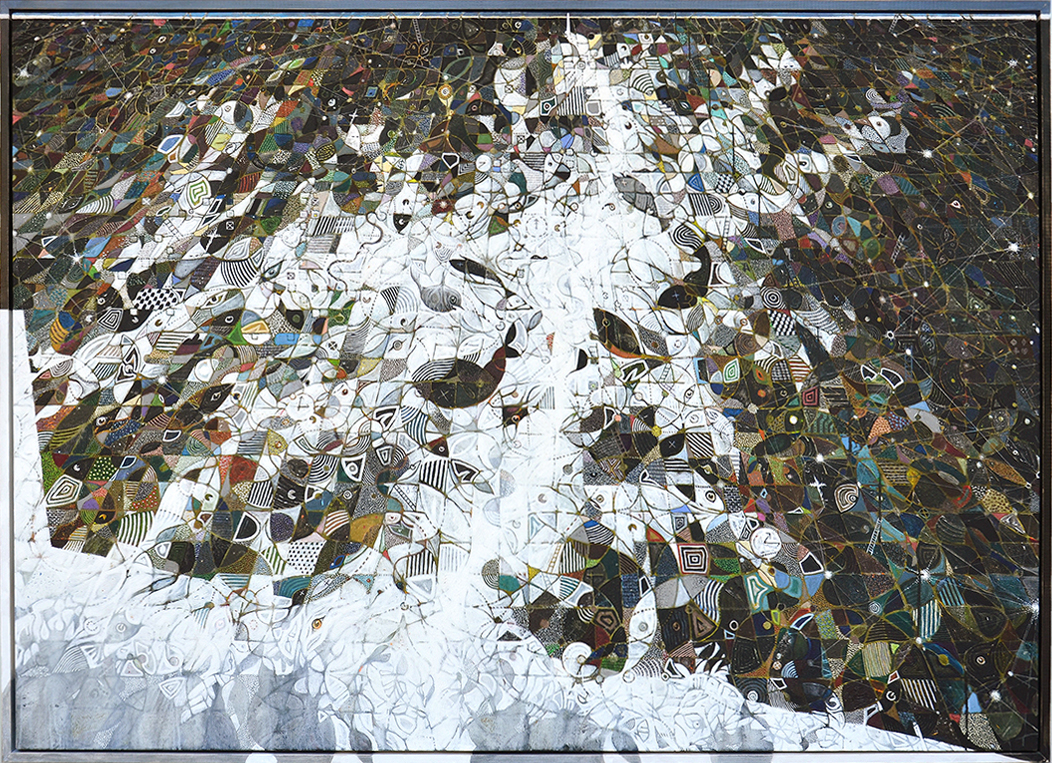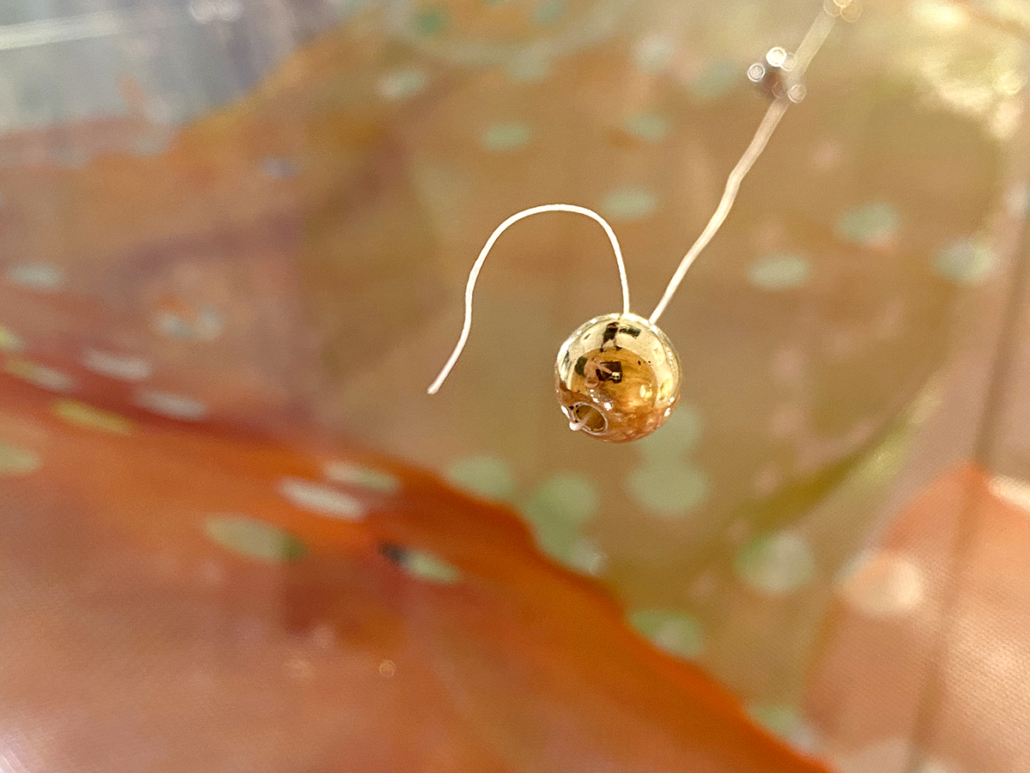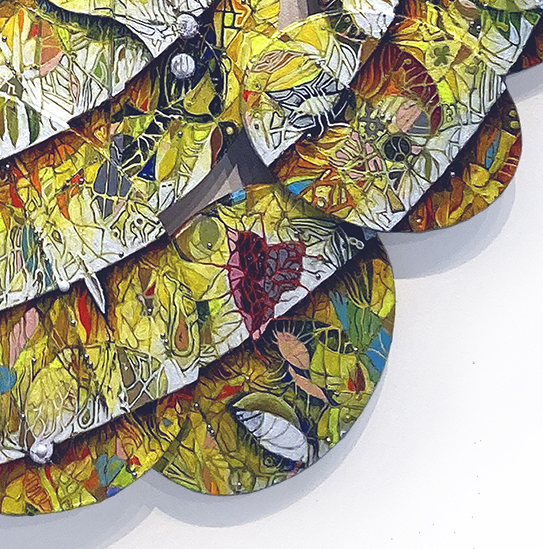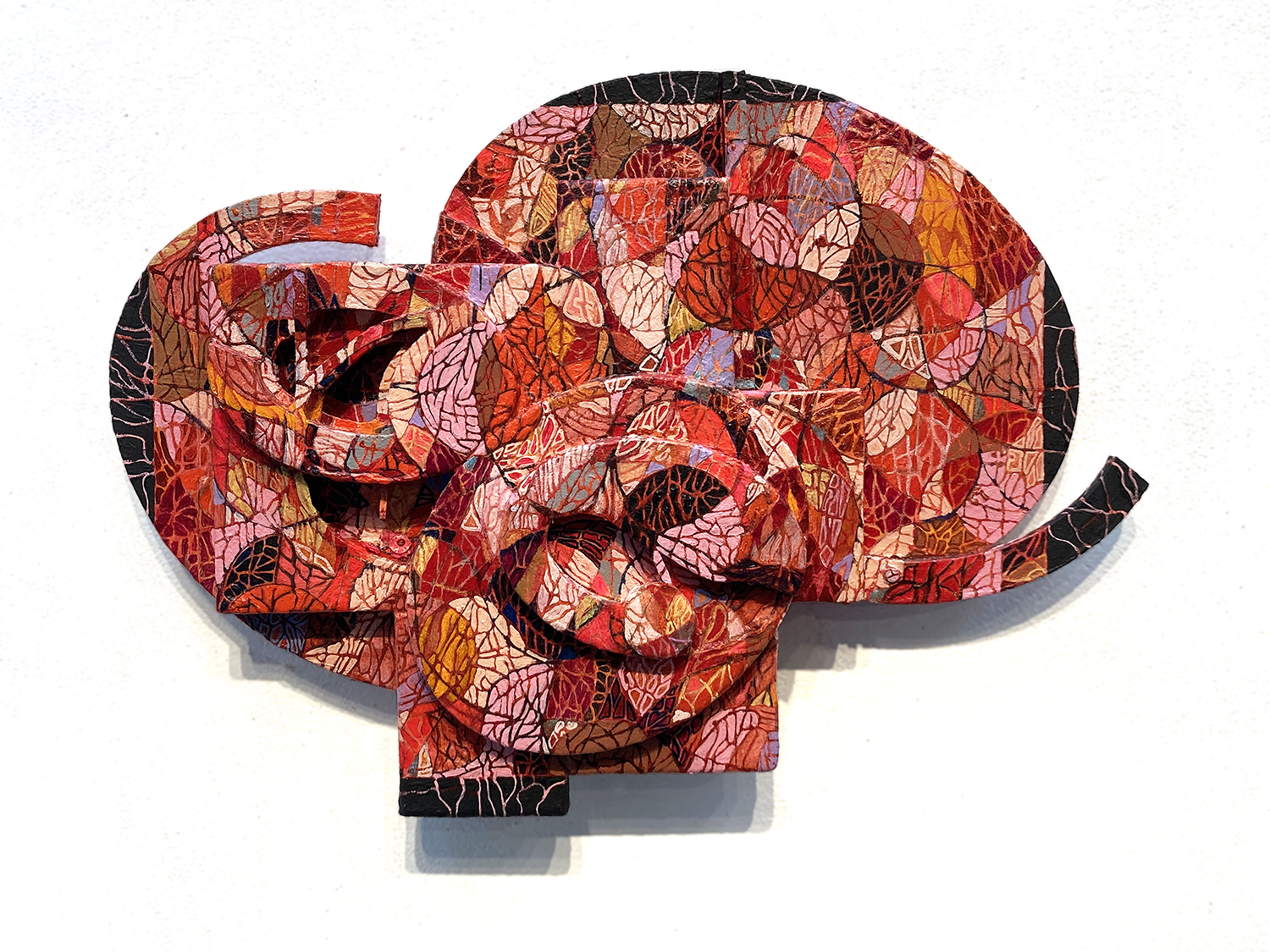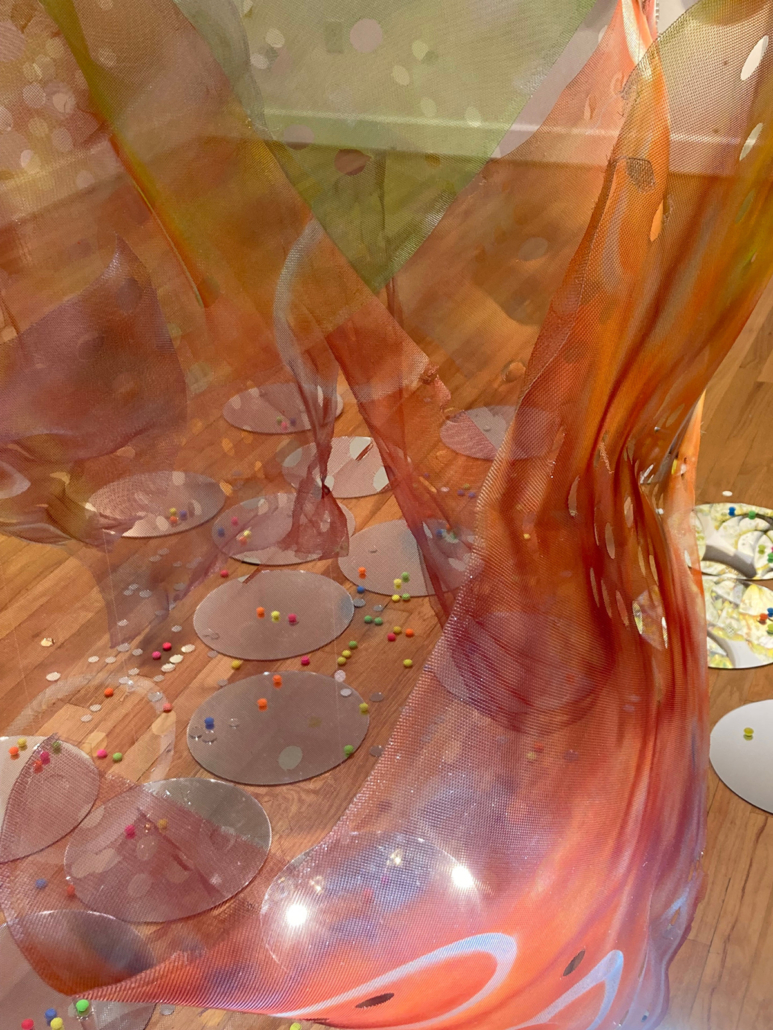When there is no way to capture a static image of a piece, no good way to measure its dimensions. When it is impossible to list the media with which it has been created (because key to its ingredients is your own observation, movement throughout the space, expansion of mind) – all we are left with is poetry and metaphors.
In the center of the room, an ethereal sculpture has been created on the spot – starting only with a vision – no sketches or drawings were created ahead of time. Yards of metal mesh screen twist and contract to the central point in the floor, spray painted, masking some areas creating ghostly circles, pushing holes in other places to reveal what lies behind.
Let’s dive right into the imagery to give you context for this discussion – a collage of photographs, taken while walking around the piece, kneeling, … even lying on the floor. No angle of the room is void of color, light, and wonder.
Untitled suspended screen structure (detail)
aluminum screen, spray paint, mirrors, thread, beads, wood plugs, dimensions variable
CONVERSATION.04
CREATOR + WORK: BEING HERE NOW.
“The poetic image is a sudden salience on the surface of the psyche”
~ Gaston Bachelard, The Poetics of Space
K: While creating this installation, I had been thinking of the transition from a 2-D piece to a 3-D piece, and wondering: “What is required for the different thought processes?” I consider the screens of the installation as 2-D work, but it is just realizing 3-D form.
There are layers upon layers of thin washes that are represented in the screens themselves. When I consider this painting process on translucent material – it’s as if I have peeled off thin veils from other work. Images of gossamer webbing are evoked in my mind. They are thin, very fragile, but strong at the same time. So I feel as if I have actualized them in a completely different form.
Is everyone seeing the same thing I’m seeing? No, we won’t. But, are you seeing enough to gain a different perspective on it? I hope so.
We see things from a vantage point of our own values, experiences, and environment, so to speak.
SPACE + WORK: OBSERVING WITH NEW EYES.
“When the image is new, the world is new.”
~ Gaston Bachelard, The Poetics of Space
How do you begin to install a space?
K: I like to begin with a generalized plan. When I start to transition the pieces from my studio to a gallery space, I measure the space and create a floor plan. Sometimes I will cut pieces of paper relative to the size of the work.
I had a generalized plan and vision for this suspended screen piece, and wanted it to reside in the middle of the room. It previously only consisted of four components, but as I was installing it here, it gradually grew to have an additional, fifth piece. It evolved when I added the vortex-like feature at the bottom. Wanting to incorporate geometric forms, I added small metal, metallic, and plastic beads. They pick up on line, shapes, and even add a little sheen, shine and points of interest. Circles are also repeated in areas that I blocked out as I spray painted onto the screen, and with the punched out circles scattered throughout the surface.
These wire screens also hold memory, so you can bend them. There is a fluid-like quality to the surface as you twist them, which creates ripples.
This is interesting, because, unlike the paintings, the process of installing this piece is creating it.
K: Right. There is only so much I can do leading up to that moment. I love the part of asking, “How can I make this unique for this particular room.”
That’s made me wonder about the conversation between the space and the work. How would this collection’s conversation change if it were installed in a different sequence, in another space?
K: I would love to see that. What would happen if this work were installed in a larger space, for example, and the larger pieces had more space to breathe. Even the central wire screen sculpture would change. The basic composition would remain (broader at the top, narrowing to a vortex at the bottom), but I could see numerous configurations.
I like the punched out holes because they reveal what is on the other side of the screen. Like here, where the far white wall comes through. But here where another layer of screen lies behind, they look like dark grey circles. This amplifies the concept of negative and positive space.
K: How and when does form connect with us? How do we create the form, and how do we witness it?
Untitled suspended screen structure, 2022
(detail, in foreground)
aluminum screen, spray paint, mirrors, thread, beads, wood plugs, dimensions variable
(L to R) eureka, paysage 75, and bang green
VIEWER + WORK: LEAVING FEAR AT THE DOOR.
“Wolves in shells are crueler than stray ones.”
~ Gaston Bachelard, The Poetics of Space
Just like one walks into this space, bringing their own ideas and intentions, by standing in different spots around this piece, you get a whole different experience. The viewer is dictating the experience just by moving around. No two people will see the same thing.
K: I want this work to jolt people out of their comfort zones. This centrally installed wire piece is a bit of a disrupter to view sheds of the other pieces. This is intentional. By having an interruption to the expectation of what people are normally anticipating when going to a gallery show of paintings (standing in front of one, moving on to the next), I am hoping it challenges the viewer in some way. This is not my intention with all of my work, but with this, I do want people to walk in, take stock for a moment, and realize that this is not what they expected. If they’re open to the experience they might say, “Let me be open to that lack of control, and let me find something new in someone else’s perspective.”
When people look at art, are they longing for answers? Do they get uncomfortable when they look at something and more questions arise for them? Or, is this part of the process do you think?
The relationship between the viewer and the art. Different types of viewers: some crave control or have expectations; you are inviting them to be open to their experience. Are you also interrupting their experience?
K: It could be both. The big question for me as an artist is, “How often do I work for myself, and how often do I work with other people in mind?” Some lines of thought around this are if you are working with other people in mind, then your work is no longer pure. I think of it as intellectual engagement. I ask myself, “How do I intellectualize my own process?”
For example, if I am exploring geometry within the system of order, and then I populate a series of work with this concept (be it figurative or abstract), this develops my cerebral process for that idea. Also knowing that much of this is based on intuition. Sure there are forms and shapes that comprise the work, that are broken down into polygons, ellipses, etc. But the intuitive process is just allowing what might occur, like the pareidolia phenomenon where one finds meaningful information in rather obtuse or ambiguous areas.
And is there always both? When I approach creating something, the possibilities are so infinite, that one must begin with a framework of parameters. But, is intuition a necessary piece, or does that depend on what kind of art you are creating? I think what I am asking is, “What role does intuition play?”
K: That is an interesting question. Where does intuition start, and where does it stop? And, what is the impetus for it? While you were speaking, I kept thinking about the beginning phases of beginning the dark piece at the other side of the screen sculpture. While creating this new piece on top of an older work, I remember the intuitive process came in because I became so frustrated with the former piece. The older piece was almost all yellow, with bright hues and it just wasn’t working. And that’s when I put on a layer of black.
overtopping
2019, mixed media on canvas and wood, 62 × 86 inches
How does it feel sometimes when you reflect on how much time you have spent on something, realize it is not right … then what?
K: That’s the difficult part of the “business of art,” right? Because if you keep track of your time (i.e. time is money), it might drive you crazy. So that idea of time, to me, doesn’t really exist in the studio. Basically, the work is most important.
That keeps it authentic. Like you have said, you already have the “creator,” “viewer,” and then you add the “business model of time” – that’s a decision that has to be made of: “Who’s in the room?”
K: Correct. Which one of me, and how many of me are in there?
{both laugh}
Right, and who’s invited?
K: I think with any creative person, that’s a personal decision. I work more alone and in isolation, instead of with people in the room.
I look at all of this work, and realize there are conversations … I could switch my mind from different pieces, and almost pick up the conversations where I left them off.
One of the people at the reception was very astute. She said, “I’m curious if you could go back to each one of these and remember the last thing you did.”
Oh, I love that.
K: So did I. It’s returning to that idea that each of these pieces has had its own history. In their former lives of previous iterations, they have travelled out of the studio for exhibitions, returned, sat against a wall for another day, a new life – a new solution when the former one became irrelevant.
Untitled suspended screen structure (detail)
aluminum screen, spray paint, mirrors, thread, beads, wood plugs, dimensions variable
WORK + WORK: VIEWING ON THE EDGE.
“It is better to live in a state of impermanence than in one of finality.”
~ Gaston Bachelard, The Poetics of Space
I was just wondering, sequentially, did you create “a ribbon at a time,” with the detailing here that looks like arteries and organs before you did “diastolic”? Are the threads between the pieces evident? I wonder if an archaeologist could trace your steps.
a ribbon at a time (detail)
2022, mixed media on 45 canvases, 72 x 72 x 6.5 inches
diastolic
2022, acrylic on canvas and wood, 18 x 25 inches
K: I would think so. Maybe in 5 years, as this work continues on, you’ll see more and more threads. I like the idea of certain signs or signifiers in one piece, populate the subsequent piece. These threads and conversations between the pieces are really just different view points.
It’s almost as if there is not enough room in one piece to express all of your ideas.
K: To tell that particular story, yes, I find that to be true. So, each needs another piece to carry on the conversation. Alone, they can not hold a single narrative. To me, I see them as a collected conversation.
Think about when musicians in the 70s and 80s would produce an album. It would be a body of work, maybe around a central theme. But with each piece’s composition, I could take the album and remember the sequence for the songs – those on Side A, and Side B. I don’t see this as being any different.
When you speak about a series or body of work that revolves around a central idea, this could be intentional, or even unintentional by the artist. They could have fallen into the theme while they were working! {laughs}
And if the work were hung in a different sequence, what new conversations would the work have with each other?
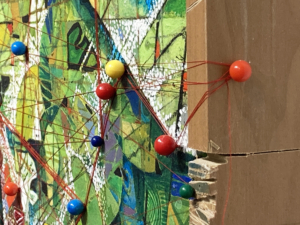 K: Right. And, I have even been thinking of what possible elements can I pull in? With the threads and map pins in “bang green,” – what if those map pins and thread pieces exploded outside of its current realm onto other pieces that were across the room?
K: Right. And, I have even been thinking of what possible elements can I pull in? With the threads and map pins in “bang green,” – what if those map pins and thread pieces exploded outside of its current realm onto other pieces that were across the room?
bang green (detail)
2020, mixed media on canvas & wood, 38 x 50 inches
Do you feel like you are in un-chartered territory? Is it exciting?
K: Yes. I’m starting to ask myself questions like, “What if all of these pieces were connected by more of the elements embedded within them?” and “What if I took these forms and began to build on this kind of armature, and they could just sit on the floor?” So now you have this painting that you can walk around it, peer through it, … I have worked with geometric 3-dimensional forms, and I see experimenting with marrying the two.
I can’t wait to see what’s next, Kenn.
K: Ah, and me as well.
“Daydream transports the dreamer outside the immediate world to a world that bears the mark of infinity.”
~ Gaston Bachelard, The Poetics of Space
This latest series, “order in an unruly zoo” will be exhibited May 6th – June 10th at Black Mountain Center for the Arts.
Open weekdays, 10am – 5pm
BMCA
225 W State St., Black Mountain, NC, 28711
828-669-0930

